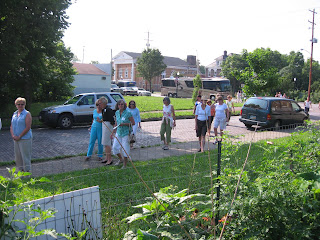



A few hardy souls got up extra early this morning to harvest produce from the SACG before today's 96 degree temperatures arrived with a vengeance. We have NO shade at the SACG, so it always feels hotter than it is. We are so lucky to have our rain barrels and tank to collect rain water off the BTBO roof because it hasn't rained since Sunday and it's been seriously hot.
On the plus side, the tomatoes are finally starting to turn red and I'll probably spend the next six weeks canning in my kitchen.
This morning, Beth, Mike and Lucy beat me to the Garden and were harvesting pumpkins when I arrived. We start them young at the SACG and Lucy was doing a great job watching the pumpkins so that they would not roll away on their own.
Betty came by to weed and put some ice packs in the cooler in the shed to preserve any extra produce which gardeners want to donate to an area food pantry when Betty makes her weekly delivery on Monday. I started her out with several squash which I harvested this morning.
I spent some time killing my old friends -- the ugly squash bugs -- and then harvested some tomatoes, squash, a cucumber, garbanzo beans, kidney beans, turtle beans, peanut beans, pink taylor beans, pinto beans, green and beans, lettuce, arugula, and flowers.
This is my first year making pickles and I couldn't be more delighted. I used garlic and dill heads from my back yard garden (as well as chili peppers I dried and saved from last year). I had difficulty accepting that one pickles cucumbers at room temperatures, but old hand Beth put my mind at ease. I hated my grandmother's homemade pickles when I was growing up, but mine taste nothing like hers. I've gone for the kosher dill from a barrel taste instead of whatever it was she was trying to make (probably sweet pickles). Now, if only I could grow cucumbers in sufficient quantities to satisfy my new pickle cravings . . . . . . .








